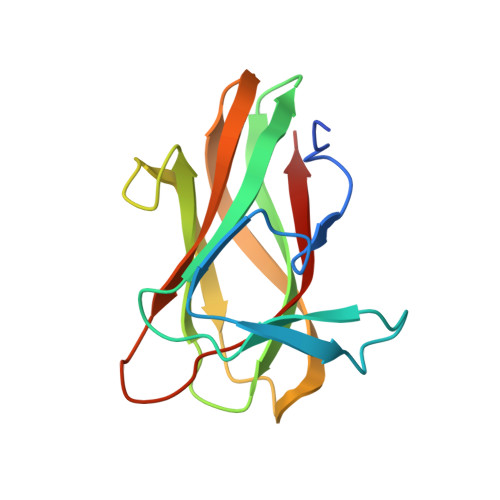Family 6 Carbohydrate Binding Modules Recognize the Non-Reducing End of Beta-1,3-Linked Glucans by Presenting a Unique Ligand Binding Surface
Van Bueren, A.L., Moreland, C., Gilbert, H.J., Boraston, A.B.(2005) J Biol Chem 280: 530
- PubMed: 15501830
- DOI: https://doi.org/10.1074/jbc.M410113200
- Primary Citation of Related Structures:
1W9S, 1W9T, 1W9W - PubMed Abstract:
Enzymes that hydrolyze insoluble complex polysaccharide structures contain non-catalytic carbohydrate binding modules (CBMS) that play a pivotal role in the action of these enzymes against recalcitrant substrates. Family 6 CBMs (CBM6s) are distinct from other CBM families in that these protein modules contain multiple distinct ligand binding sites, a feature that makes CBM6s particularly appropriate receptors for the beta-1,3-glucan laminarin, which displays an extended U-shaped conformation. To investigate the mechanism by which family 6 CBMs recognize laminarin, we report the biochemical and structural properties of a CBM6 (designated BhCBM6) that is located in an enzyme, which is shown, in this work, to display beta-1,3-glucanase activity. BhCBM6 binds beta-1,3-glucooligosaccharides with affinities of approximately 1 x 10(5) m(-1). The x-ray crystal structure of this CBM in complex with laminarihexaose reveals similarity with the structures of other CBM6s but a unique binding mode. The binding cleft in this protein is sealed at one end, which prevents binding of linear polysaccharides such as cellulose, and the orientation of the sugar at this site prevents glycone extension of the ligand and thus conferring specificity for the non-reducing ends of glycans. The high affinity for extended beta-1,3-glucooligosaccharides is conferred by interactions with the surface of the protein located between the two binding sites common to CBM6s and thus reveals a third ligand binding site in family 6 CBMs. This study therefore demonstrates how the multiple binding clefts and highly unusual protein surface of family 6 CBMs confers the extensive range of specificities displayed by this protein family. This is in sharp contrast to other families of CBMs where variation in specificity between different members reflects differences in the topology of a single binding site.
Organizational Affiliation:
Department of Biochemistry and Microbiology, University of Victoria, British Columbia V8W 3P6, Canada.



















